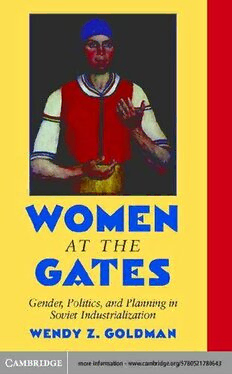
Women at the Gates: Gender and Industry in Stalin's Russia PDF
Preview Women at the Gates: Gender and Industry in Stalin's Russia
This page intentionally left blank WOMEN AT THE GATES In the annals of industrialization, the Soviet experience is unique in its whirlwindrapidity.ThevasttransformationsthatshookwesternEurope over the centuries – proletarianization, industrialization, urbanization – wereintheSovietUniontelescopedintoameredecade.Theworkingclass grew at an unprecedented rate, changing in size and social composition. Even more striking was the critical role of women: in no country of the worlddidtheycometoconstitutesuchasignificantpartoftheworking classinsoshortatime.Aswomenfloodedindustriestraditionallydom- inated by men, they undercut strict hierarchies within the factories and forcedmaleworkerstoreexaminetheirideasaboutskill,“masculine”and “feminine”work,andtheroleofwomenintheworkplace.Thestate’suse offemalelaborwascloselyintertwinedwiththegreatupheavalsofearly Soviethistory:accumulationofcapitalfortheindustrializationdrive,the urban food crisis, collectivization, and peasant migration to the cities. BasedonnewRussianarchivalmaterials,WomenattheGatesisthefirst social history of Soviet women workers in the 1930s. It is the story of a worldremade,fromaboveandfrombelow,asplanners“regendered”the entireeconomyandwomenenteredtheranksofwagedlaborinunprece- dentednumbers. WendyZ.GoldmanisProfessorofHistoryatCarnegieMellonUniversity. She is author of Women, the State and Revolution: Soviet Family Policy and Social Life, 1917–1936 (Cambridge University Press, 1993), which wontheBerkshirePrizeforthebestbookinhistorywrittenbyawoman. She travels frequently to Russia and is the author of many articles on Sovietsocialhistory. WOMEN AT THE GATES GENDER AND INDUSTRY IN STALIN’S RUSSIA WENDY Z. GOLDMAN CarnegieMellonUniversity Cambridge, New York, Melbourne, Madrid, Cape Town, Singapore, São Paulo Cambridge University Press The Edinburgh Building, Cambridge , United Kingdom Published in the United States of America by Cambridge University Press, New York www.cambridge.org Information on this title: www.cambridge.org/9780521780643 © Wendy Z. Goldman 2002 This book is in copyright. Subject to statutory exception and to the provision of relevant collective licensing agreements, no reproduction of any part may take place without the written permission of Cambridge University Press. First published in print format 2002 - isbn-13 978-0-511-06897-3 eBook (EBL) - isbn-10 0-511-06897-2 eBook (EBL) - isbn-13 978-0-521-78064-3 hardback - isbn-10 0-521-78064-0 hardback isbn--13 978-0-521-78553-2 paperback - isbn-10 0-521-78553-7 paperback Cambridge University Press has no responsibility for the persistence or accuracy of s for external or third-party internet websites referred to in this book, and does not guarantee that any content on such websites is, or will remain, accurate or appropriate. Thisbookisdedicated toMarcusRediker and tothememoryofourbelovedfriend StevenSapolsky Contents Acknowledgments pageix ListofIllustrations xi ListofTables xiii AcronymsandAbbreviations xv Introduction 1 1 GuardingtheGatestotheWorkingClass:Womenin Industry,1917–1929 5 2 TheStruggleoverWorking-ClassFeminism 33 3 TheGatesComeTumblingDown 70 4 FromExclusiontoRecruitment 109 5 “TheFive-YearPlanforWomen”:PlanningAbove, CounterplanningBelow 143 6 PlanningandChaos:TheStruggleforControl 179 7 GenderRelationsinIndustry:VoicesfromthePoint ofProduction 207 8 RebuildingtheGatestotheWorkingClass 234 Conclusion 278 Index 287 vii
